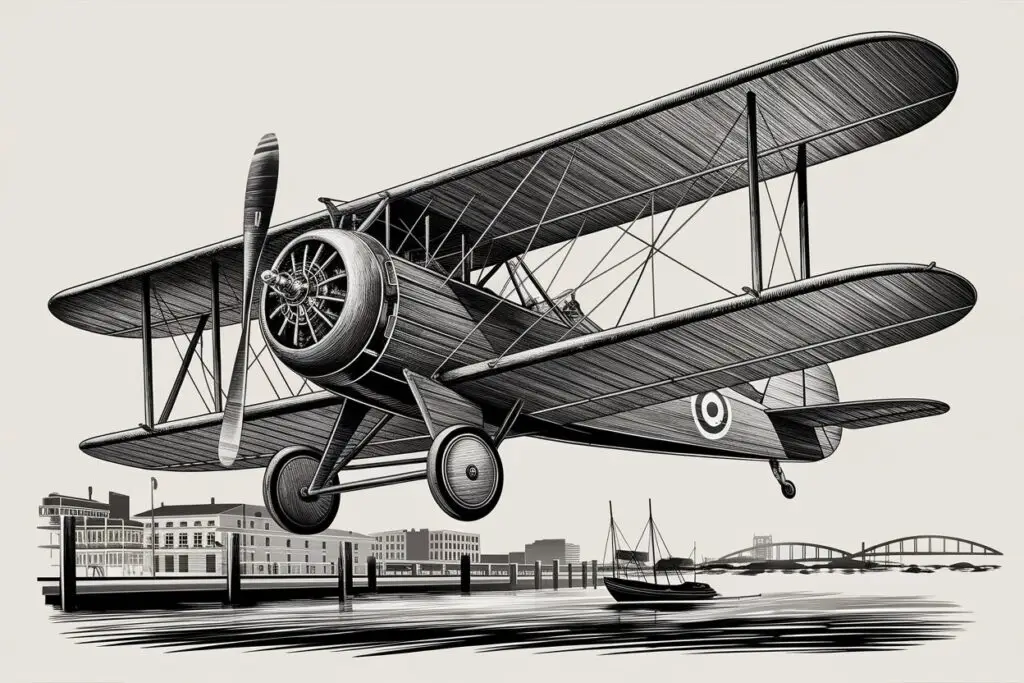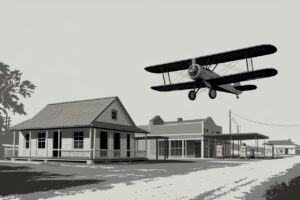Welcome to St. Petersburg—Where Commercial Flight Took Off
When people think of the birth of commercial aviation, their minds often drift toward places like Dayton or Kitty Hawk. But the real game-changer? It happened in a small Florida town best known, at the time, for its sunshine and citrus groves. On January 1, 1914, St. Petersburg, Florida etched its name into the annals of aviation history as the launchpad for the world’s first scheduled commercial airline service—the St. Petersburg–Tampa Airboat Line. The inaugural flight, piloted by aviation pioneer Tony Jannus, took off from the St. Petersburg Municipal Pier and glided across Tampa Bay in just 23 minutes—a journey that previously took two hours by steamship.

The visionary behind this airborne leap was Percival E. Fansler, a Florida-based electrical engineer who believed air travel could revolutionize regional transportation. He partnered with St. Louis aircraft manufacturer Thomas Benoist, whose Benoist XIV airboat—essentially a flying boat—was specially designed for water takeoffs and landings. With just one passenger seat, the aircraft wasn’t luxurious, but it was groundbreaking. The first ticket was auctioned off for $400 (a staggering sum in 1914), won by former St. Petersburg mayor Abram C. Pheil, who became the world’s first paying airline passenger.
This modest 23-mile flight wasn’t just a publicity stunt—it was a prototype for the future of global travel. As the Benoist airboat skimmed over the bay at a height of 50 feet, it carried with it not just one man, but the collective dream of an interconnected world. And while the airline itself lasted only three months, its legacy is immortalized in the very airfields, monuments, and museums that now dot the St. Pete waterfront. A century later, the city still proudly bears the title: the birthplace of commercial aviation.
The First Ticketed Airline Passenger Flight in 1914
The story of commercial air travel begins not in New York or Paris, but in a small Florida town with a big vision. On January 1, 1914, St. Petersburg made history as the departure point for the world’s first scheduled commercial airline flight. The aircraft? A Benoist XIV airboat, number 43. The pilot? Tony Jannus, a daring aviator already known for his overwater exploits. And the first paying passenger? Former St. Petersburg mayor Abram C. Pheil, who secured his seat by winning a charity auction with a $400 bid—roughly equivalent to $11,200 today. That single, 23-minute hop across Tampa Bay may seem modest by today’s standards, but it marked the dawn of a new era.
The flight was the brainchild of Percival E. Fansler, a visionary entrepreneur who partnered with aviation manufacturer Thomas Benoist to found the St. Petersburg–Tampa Airboat Line—the first scheduled heavier-than-air airline in the world. Backed by local investors like L.A. Whitney and Noel Mitchell, the project launched with two aircraft, each capable of carrying one or two passengers alongside the pilot. Regular fares were set at $5 (about $140 today), and over the airline’s three-month lifespan, it carried 1,205 passengers—solid numbers for a brand-new mode of transport.
But it wasn’t all smooth flying. During that inaugural flight, engine misfires forced Jannus to land briefly on the waters of Tampa Bay before completing the journey. Still, the spectacle drew a crowd of over 3,000 onlookers, including humorist Will Rogers, who surely sensed the magnitude of what they were witnessing. Though the airline folded after a few months due to financial limitations, its significance was profound. It proved that scheduled air transport was not only possible but practical—a radical notion at a time when most Americans had never even seen an airplane. The legacy of that flight lives on, commemorated by the Tony Jannus Distinguished Aviation Society and a life-size sculpture at the St. Pete Pier, standing as a testament to the day the future of travel took off—literally.
The Benoist Airboat and Its Historic Journey Across Tampa Bay
The Benoist Airboat wasn’t just a curious contraption of wood and wire—it was the vessel that launched the age of commercial flight. Built by aviation pioneer Thomas W. Benoist, the Model XIV flying boat was the centerpiece of the St. Petersburg–Tampa Airboat Line, the world’s first scheduled airline service. On January 1, 1914, this shallow-hulled aircraft—with its 75-horsepower Roberts engine and open cockpit—took off from the Municipal Pier in St. Petersburg and flew into history. The trip to Tampa took just 23 minutes, a dramatic improvement over the two-hour boat ride or 12-hour train journey that had previously connected the two Florida cities.

Piloted by the daring Antony Jannus, the Benoist No. 43 carried only one passenger: former St. Petersburg mayor Abram C. Pheil, who had paid $400 (roughly $11,000 today) in a charity auction for the honor. Despite engine misfires that forced a brief water landing in Tampa Bay, the flight was completed successfully at an altitude of just 50 feet—low enough for the crowd of 3,000 spectators to cheer every moment of the journey. Designed for water takeoffs and landings, the Benoist’s wooden hull made it uniquely suited for Florida’s coastal environment, and its relatively modest specs—44-foot wingspan, 1,250-pound dry weight, and 64 mph top speed—belied its revolutionary impact.
Though the airline operated for only three months, the Benoist’s legacy is anything but ephemeral. A life-sized replica now stands at the Benoist Centennial Plaza on the very site of the original hangar, while another is housed at the St. Petersburg Museum of History. These tributes serve as reminders that the humble airboat, once skimming low over Tampa Bay, helped chart the course for a global industry. As the first aircraft to carry a paying passenger on a scheduled route, the Benoist didn’t just cross a stretch of water—it crossed a threshold into the modern age.
How Local Support Turned a Dream Into Reality
The story of the world’s first scheduled commercial airline didn’t begin with a government grant or a corporate boardroom—it began with a handful of passionate locals in a small Florida town who believed in the improbable. In late 1913, Percival E. Fansler, an enterprising Jacksonville-based sales agent with a flair for aviation dreams, pitched an idea: a daily airboat line connecting St. Petersburg and Tampa. At the time, the 21-mile trip could take up to 12 hours by rail or boat. Fansler’s proposal was audacious, but it struck a chord with civic leaders eager to put their town on the map.
Financial backing came swiftly. Local trade manager L.A. Whitney and businessman Noel Mitchell helped raise $2,200—roughly $60,000 today—by rallying area investors willing to bet on aviation’s promise. The St. Petersburg Board of Trade sealed the deal with a three-month contract signed on December 17, 1913, pledging to cover losses if the venture failed to break even. Even more crucially, they offered the city’s Municipal Pier as a launch site—effectively creating the world’s first commercial airline terminal.
Then came the people. On New Year’s Day 1914, over 3,000 spectators—nearly half the town’s population—lined the waterfront to witness history. Former mayor Abram C. Pheil, who secured his seat by winning a $400 charity auction, became the first paying passenger. The community’s enthusiasm didn’t wane after the fanfare. Over the next three months, the St. Petersburg–Tampa Airboat Line ran 172 flights and carried more than 1,200 passengers, managing to stay financially self-sufficient for two months despite its brief lifespan.
This wasn’t just a local stunt—it was a prototype for global air travel. And it only happened because a small town rallied behind a big idea.
The Role of Pilot Tony Jannus in Aviation History
Tony Jannus wasn’t just in the cockpit of the world’s first scheduled commercial airline flight—he was carving out an entirely new chapter in human mobility. Born in Washington, D.C., in 1889, Jannus had a mechanical mind and a daredevil’s spirit, both of which propelled him into aviation’s earliest days. By 1910, he was already flying, and within two years, he had achieved a milestone that turned heads: piloting the first airplane from which a parachute jump was successfully made. But it was his 23-minute flight across Tampa Bay on January 1, 1914, that would etch his name into the history books.

That flight—aboard a Benoist XIV airboat from St. Petersburg to Tampa—was far from a smooth glide. The aircraft, which reached a modest 50 feet in altitude, sputtered with engine misfires, forcing Jannus to land on the bay for repairs mid-flight. Yet with calm precision, he resolved the issue and completed the journey, delivering former St. Petersburg mayor Abe Pheil as the world’s first paying airline passenger. Jannus’s feat wasn’t just a daring stunt—it was a proof of concept that air travel could connect cities and people in ways previously unimaginable.
Jannus continued to push boundaries after that inaugural flight. He became a test pilot for both the Benoist Aircraft Company and later the Curtiss Aeroplane Company, and even traveled to Russia in 1915 to train pilots during World War I. Tragically, his life was cut short in 1916 when his Curtiss H-7 crashed into the Black Sea during a training mission. His body was never recovered, but his legacy was anything but lost. In 1964, the Tony Jannus Distinguished Aviation Society was established in Tampa to honor his pioneering contributions, and today, a life-sized replica of his Benoist airboat stands at St. Pete Pier’s Benoist Centennial Plaza—marking the exact site where commercial flight took off, quite literally, thanks to Jannus’s steady hands and fearless vision.
The Impact of St. Petersburg’s Flight on Global Travel
The small Florida town of St. Petersburg may not seem like the epicenter of a global revolution—but on January 1, 1914, it quietly redefined the future of transportation. That morning, a Benoist Model XIV airboat, piloted by Tony Jannus and carrying former mayor Abe Pheil, lifted off from the downtown pier and glided 23 minutes across Tampa Bay. It was the world’s first scheduled commercial airline flight—a feat that, though modest in scale, would ripple across decades and continents. Before that flight, the trip between St. Petersburg and Tampa took over six hours by rail or boat. Suddenly, air travel compressed time and space in a way that had once seemed impossible.
The St. Petersburg–Tampa Airboat Line, though it lasted only three months, shattered the idea that airplanes were just daring novelties or military tools. It proved people would pay for the speed and convenience of air travel—$5 a ticket in 1914, or about $115 today. That simple economic exchange marked the beginning of a commercial model that now moves over 4.5 billion passengers annually around the globe. The flight’s legacy isn’t just measured in passenger statistics or airport terminals—it’s embedded in the DNA of global connectivity. As President Barack Obama once remarked, this humble first flight helped shape the very industry that now links economies and cultures on a planetary scale.
Even Albert Whitted Airport, named in honor of naval aviator Lt. James Albert Whitted, carries forward that legacy. In 2012 alone, it contributed roughly $33 million to the local economy and supported over 350 jobs—proof that the economic engine first sparked by Jannus’s flight is still humming. The pioneering vision of Jannus, Fansler, and Benoist didn’t just launch a plane across the bay. It launched the modern world into the air.
How the Town Celebrates Its Aviation Legacy Today
St. Petersburg doesn’t just remember its aviation legacy—it lives it. At the heart of this commemoration is the Benoist Centennial Plaza on the St. Pete Pier, where a life-sized sculpture of the Benoist Model XIV airboat stands poised as if ready to take off again over Tampa Bay. This striking monument marks the very site of the original hangar used by the world’s first scheduled airline, the St. Petersburg–Tampa Airboat Line, which took flight on January 1, 1914. The sculpture isn’t just a tribute to a machine; it’s a salute to the spirit of innovation that soared from this small Florida town and reshaped global transportation forever.
Just steps away, the St. Petersburg Museum of History deepens the experience. Inside, visitors can explore a meticulously crafted replica of Airboat No. 43—the same aircraft piloted by Tony Jannus with Mayor Abe Pheil as the first paying passenger. The museum’s exhibit includes original artifacts, photos, and documents that transport guests back to a time when aviation was more daredevil than dependable.
But the town’s homage doesn’t end with static displays. Since 1964, the Tony Jannus Distinguished Aviation Society has kept the legacy aloft by honoring individuals who have made extraordinary contributions to commercial aviation. The annual Tony Jannus Award has recognized aviation pioneers from astronaut Frank Borman to JetBlue founder David Neeleman, cementing St. Petersburg’s ongoing influence in the skies source.
Even Albert Whitted Airport—named after local World War I naval aviator Lieutenant James Albert Whitted—plays a role in this living history. Once a hub for Coast Guard air operations during World War II, the airport now supports private and chartered flights, and it contributes an estimated $33 million to the local economy. For aviation buffs and casual diners alike, the terminal’s second-floor restaurant offers front-row seats to the runway—where the past and present of flight converge with every takeoff.
In St. Petersburg, the story of commercial aviation isn’t tucked away in the archives—it’s on full display, proudly embedded in the city’s skyline, shoreline, and spirit.







